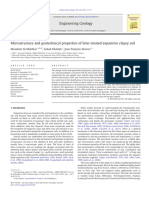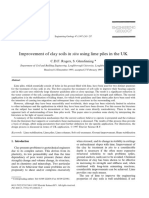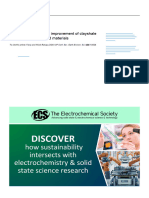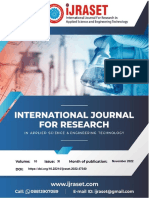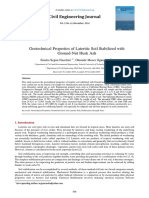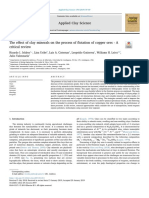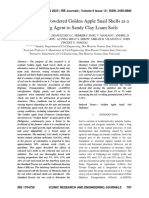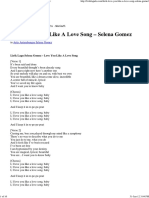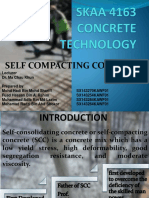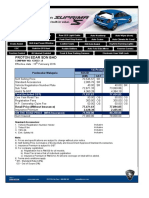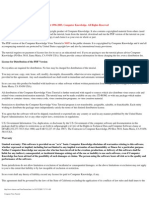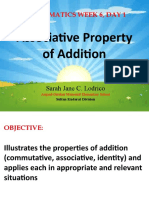Islamic Calendar Ummulqura 2019 Ce
Islamic Calendar Ummulqura 2019 Ce
Uploaded by
fuadhassanarCopyright:
Available Formats
Islamic Calendar Ummulqura 2019 Ce
Islamic Calendar Ummulqura 2019 Ce
Uploaded by
fuadhassanarOriginal Description:
Copyright
Available Formats
Share this document
Did you find this document useful?
Is this content inappropriate?
Copyright:
Available Formats
Islamic Calendar Ummulqura 2019 Ce
Islamic Calendar Ummulqura 2019 Ce
Uploaded by
fuadhassanarCopyright:
Available Formats
See discussions, stats, and author profiles for this publication at: https://www.researchgate.
net/publication/266675947
Characterization of Hydrated Lime-Stabilized Brown Kaolin Clay
Article · November 2013
CITATIONS READS
3 257
5 authors, including:
Khitam Abdulhussein Saeed Khairul Anuar Kassim
Universiti Teknologi Malaysia Universiti Teknologi Malaysia
23 PUBLICATIONS 685 CITATIONS 168 PUBLICATIONS 774 CITATIONS
SEE PROFILE SEE PROFILE
Nor Zurairahetty Mohd yunus
Universiti Teknologi Malaysia
65 PUBLICATIONS 161 CITATIONS
SEE PROFILE
Some of the authors of this publication are also working on these related projects:
Intelligent prediction for evaluation of single pile bearing cpaacity using Pile Dricving Analyzer (PDA) datas View project
Sustainable stabilization of marine clay using waste materials View project
All content following this page was uploaded by Nor Zurairahetty Mohd yunus on 10 October 2014.
The user has requested enhancement of the downloaded file.
International Journal of Engineering Research & Technology (IJERT)
ISSN: 2278-0181
Vol. 2 Issue 11, November - 2013
Characterization of Hydrated Lime-Stabilized Brown Kaolin Clay
Khitam A. H. Saeed1, Khairul A. Kassim2, HadiNur3, and Nor Zurairahetty M. Yunus4
1
Faculty of Civil Eng. University Technology Malaysia.
2
professor at Faculty of Civil Eng. University Technology Malaysia
3
Professor of Chemistry University Technology Malaysia.
4
Lecturer at Faculty of Civil Eng. University Technology Malaysia,
Abstract comparatively high in Malaysia, making a lime
economically applicable selection for the treatment
The effect of the calcium-based stabilizers like lime of tropical soils [5]. Lime used to improve the
on the clay soil characterizations has been studied bearing capacity of the layers in highway, railway,
in this research. This study was carried out in an and airport buildings. It is also used as the basis for
attempt to identify the time-dependent soil- lightweight structures, such as fill material for
chemical reactions for lime chemically stabilized retaining walls, and as a side support in excavations
Brown Kaolin clay samples. The data for the study and trenches. Therefore, due to the proven
of characteristics of treated samples were obtained versatility of lime stabilization, the method has
from X-ray diffractometer (XRD), field emission been gained wider acceptance in different countries
scanning electron microscopy (FESEM), and of the world, and most recently in Southeast Asia
Fourier transform infrared spectroscopy (FTIR). [6].
Furthermore, to illustrate the effect of lime on the
strength, a series of laboratory tests were carried
out by unconfined compressive strength. Based on 2. Mechanism of Lime Reactions
the micro-structural analyses, it was observed that When a soil is mixed with lime, two mechanisms
RT
kaolinite is rapidly exhausted by pozzolanic reactions occur. These reactions can be classified
reactions to produce the Gismondine (CASH), into short-term reactions (modification or
which is responsible on gain the strength for the flocculation) and long-term
IJE
lime treated samples with progressing time. On the (solidification/stabilization) as stated by [7]. During
other hand, it was noticed Illite mineral did not the short-term phase, the calcium ions (Ca++) from
show any reacted with advancing time. In addition, hydrated lime migrate to the surface of the clay
based on the morphology of the treated samples, particles and displace water and other ions. Thus,
the presence of the cementious products were as a result to this reaction, increasing in the pH of
observed. These outcomes proved the effectiveness the pore water was occurred. Furthermore, the soil
of lime to stabilize kaolin clay. becomes friable and granular due to the
flocculation of soil aggregates, making it easier to
1. Introduction work and compact include. Cation exchange and
The clay mineralogy has significant effect on carbonation were included also within this term of
the soil characterization. Kaolinite is geochemically reactions. These reactions influence the physical
and industrially extremely versatile. These minerals properties (i.e. Atterberg limits and particle size
form in tropical climatic conditions of the region distribution) of the soil. Moreover, an increase in
where rainfall is comparatively high, and there is strength caused by both the dehydration and
good drainage to confirm cation leaching and iron fundamental changes in the clay particle chemistry
acids granitic rocks [1]. On the other hand, Kaolin is accompanied in this reaction.
soil is soft clay deposits. Furthermore, it has While, the reactions that take place after the
predominantly poor engineering characterizations, modification phase, which are attributed to the long
which are lead to occur high compressibility, high term reactions, are time dependent and continue for
plasticity, poor workability, and low shear strength. a long period. These reactions lead to produce the
Therefore, using these soft deposits for pozzolanic reactions [8]. The formation of various
construction structures, lead to many geotechnical cementing products will bind the aggregates, thus
problems. For that, to encounter these problems, increase the strength of the clay soils.
chemical stabilization should be applied. It should be noted that the most of previous
The calcium-based stabilizer confirmed its research considered only the physical
efficiency in improving the soil properties as characteristics of the soil parameters [9,10]. Thus,
reported by several researchers [2-4]. In Malaysia, the details studies to determine the mechanisms of
limestone is widely used. Furthermore, the lime clay reactions based on the microstructure
presence of lime in the form of hydrated lime is area were limited. Therefore, this paper aims to
IJERTV2IS111095 www.ijert.org 3722
International Journal of Engineering Research & Technology (IJERT)
ISSN: 2278-0181
Vol. 2 Issue 11, November - 2013
investigate the characteristics of hydrated lime To study the effect of hydrated lime on soil
treated Brown Kaolin samples using XRD characteristics, the treated soil was characterized
diffraction, Field Emission Scanning Electron prior and after the treatment. The methods and
Microscope (FESEM), Fourier Transform Infrared equipment used in each of these analyses are
Spectroscopy (FTIR) analysis, and to evaluate the specified as follow.
strength development of lime treated samples, UCS Powder XRD was collected to define the crystalline
test was carried out on the cured samples. minerals existed in the natural soil and also to
monitor the mineralogical changes caused by lime
3. Materials treatment. Samples for XRD test were prepared by
Slightly acidic brown pure kaolin was used as a grinding the soil using a pestle and a mortar to
material in this study. The bulk soil is purchased obtain a homogeneous fine powder. A Bruker D8
from Tapah, where it is located in the west of advance diffractometer was used to accomplish
Peninsular Malaysia. The Atterberg limits, particle scans in an angle scan (2θ) ranging between 10 to
size distribution, density and pH of kaolin were 80° with a 0.02° step size and dwelling time of one
determined in the laboratory. The physical and second at each step. Then, the mineralogy analysis
chemical composition of the soil properties are was carried out based on the characteristic Bragg
listed in Table 2. The lime used was hydrated lime data available in the standard powder diffraction
Ca (OH)2. file (JCPDS, 1995).
A JSM-6701F JEOL Field Emission Scanning
Table 2. The Physical Properties and chemical Electron Microscope (FESEM) was used also to
composition for Kaolin clay study the morphological changes and the
topographic features associated with clay particles
4. Samples Preparation
before and after treatment. Furthermore, FTIR was
Two different amounts of lime, i.e., 5 and 10% by
conducted to examine the molecular alterations in
weight of the dry soil, were chosen for this research
the structure of treated samples. Hence, 2 mg of
to prepare the treated samples. The optimum
dried soil was ground in an agate mortar and
moisture content and the max dry density were
blended with 200 mg potassium bromide (KBr) to
determined for the natural and the treated samples
produce a homogeneous powder, which was then
RT
for both the percentages of lime. Clause 3 .3. 4. 1
pressed into a solid pellet. The transparent KBr disc
of BS 1377: Part 4: 1990 was adopted to
(pellet) was then placed in a sample holder where it
accomplish the compaction test. Dry Mixtures of
was scanned using a Perkin Elmer Spectrum 2000
lime and clay are mixed with distilled water. UCS
IJE
instrument to yield a pattern of the beam
samples were prepared by placing a mixture in a
transmitted through the sample from 400 to 4000
mold (38 mm diameter x 76 mm length) under
cm-1.
constant stress of compaction, as specified in
Unconfined compressive strength (UCS) test was
BS1924: Part2: 1990 (clause 4.1.5). Then, sample
performed on cured specimens at an axial strain
was removed using a hydraulic jack and wrapped
rate of one percent per minute in accordance with
with thin plastic film. They were covered plastic
BS 1924: Part 2: 1990. The results were used as an
container with a tight lid to prevent the moisture
index of improvement.
lost during the curing time. The samples were
stored in a temperature-controlled room (27 ± 2 °
C) and tested at different curing periods of 7 days, 6. Test Results and Discussion
14 days, 28 days, 100 days and 200 days. 6.1. Compaction Test
Standard compaction test was carried on lime
5. Testing Programme stabilized Brown Kaolin clay prior to strength
(UCS) test to determine the compaction
characteristics. Figure 1 reveals the dry density-
water content relationships for kaolin clay with 5%
& 10% lime contents. As shown in the figure, the
addition of lime increased the optimum moisture
content (OMC) and decreased the maximum dry
density (MDD) with increasing lime content. This
was consistent with the study conducted by [11].
The reduction in the dry density occurs as a result
of agglomerated particles due to flocculation.
Furthermore, because the lime requires more water
for the pozzolanic reactions that leads to increase
OMC with the content of the lime growing.
IJERTV2IS111095 www.ijert.org 3723
International Journal of Engineering Research & Technology (IJERT)
ISSN: 2278-0181
Vol. 2 Issue 11, November - 2013
comparatively weak cementing agents such as
calcium carbonate, and this reaction is undesirable
because it exhausts some lime that would normally
be used to form more resistant cementitious
products [13].
Figure 1: The compaction characteristics of lime
stabilized Brown Kaolin clay
7. Microstructure Analysis
7.1. X-ray diffraction (XRD) Figure 2: XRD of untreated Kaolin clay soil
Figure 2. shows the XRD pattern of untreated
Brown Kaolin clay. The main mineralogical
constituents of untreated kaolin clay are kaolinite
Al2(Si2O)(OH)4, quartz SiO2,calcite CaCO3, and
illite (K,H3O)(AL2Si3AlO10(OH)2. However,
RT
kaolinite is the predominant clay mineral.
Furthermore, XRD-ray patterns of untreated and
10% lime treated Brown Kaolin clay samples after
7, 100, and 200 days were shown in Figure (3). As
IJE
shown in this figure, it can noticed new compounds
at 7 days curing, which are observed at 2θ of (19.8,
35.3, 40.4,50, 54,56),(17.7,20, 29.8, 34.5, 55),and
(29.2, 34.2, 47.4,64.7) for Montmorillonite,
Muscovite, and Portlandite respectively. For the
long period at 100 and 200 days, a new reflection is
attributed to the formation of Gismondine (CASH),
which is resulted from the reaction between the
Portlandite and the mixture of soil. This finding
was in agreement with [12] study. As the time Figure 3: X-ray diffraction patterns for
prolonged, the alkaline environment which is untreated and lime treated Brown Kaolin clay
responsible for the pozzolanic reaction to ensure soil after 7,
silica and alumina dissolved from solution will 100, and
increase. Thus, the pozzolanic reaction continues to 200 days
produce more CASH, which lead to increase the curing time
strength of the lime treated Kaolin soil.
Furthermore, it should be noted that the high
percentage of quartz does not assist in increasing 7.2.
the strength of lime treated Kaolin clay. Instead, it Scanning
retarded the bonding between the surface lime and Electron
clay particles. For this reason, the partially
crystallize CASH, still not entirely converted to the
crystallize compounds CSH and CAH.
Furthermore, it can be noticed the presence of
calcite, which is result from the carbonation of
calcium. Thus, as stated previously it can form Microscope Analysis
IJERTV2IS111095 www.ijert.org 3724
International Journal of Engineering Research & Technology (IJERT)
ISSN: 2278-0181
Vol. 2 Issue 11, November - 2013
The micrograph of natural kaolin clay is presented The band at 912 cm-1 corresponding to the OH
in Figure 4. It can be noticed, the neatly arranged deformation of hydroxyl groups. Most of the other
book-like kaolinite particle were the predominate
feature of the natural soil [14]. The kaolin generally Figure 5: FESEM images of 10% Lime treated
has a to-face aggregate and edge -to-edge Kaolin Clay after7, 100, and 200 days
flocculated structure [15]. Figure 5. shows the
micrograph of lime stabilized Brown Kaolin clay
samples at different intervals time. It was evident bands such as the Si–O vibrations observed at 794
there is insignificant modification in the texture of cm-1, 698 cm-1, 540 cm-1, and 470 cm-1, also
the lime-kaolin matrix at 7 days curing time. In
addition it can detect little flocculated parts with confirmed the presence of kaolinite mineral.
small signs of Ca(OH)2 as a result to starting lime
dissolution. At 100 and 200 days curing, it was
apparent that the degree of crystal formation and
the fabric texture of lime-stabilized matrix are
developed with time. It can recognize parts of
reticulation phases and the evident of white lumps.
These changes are attributed to the progressing in
the process of lime reaction and producing calcium
alumina silicate hydrated (gismondine), which is
responsible for the long-term strength performance
of stabilized specimens.
RT
IJE
Figure 4: FESEM image of untreated Kaolin
clay soil
8. Molecular Characteristics Furthermore, the small band at 1422cm-1 relates to
the presence of calcite. While, the bonding mode
8.1. FTIR
Infrared spectroscopy was carried out in this vibration of water molecules H-O-H is observed at
1638cm-1.
research, to examine the influences of hydrated
FTIR spectroscopy was also conducted on lime
lime on the molecular structure of treated Kaolin
soils. treated Brown Kaolin clay samples as presented in
The FTIR spectrum of natural Brown Kaolin soil is Figure (7). It can detect increasing the intensity of
shown in Figure (6). As can see, kaolinite was absorbance band at 1425cm-1 due to increasing the
sources of calcium, which are supplied from the
identified by two strong bands at 3696 and 3620
lime addition. It was also observed a slight
cm-1. These bands were related to the octahedral
increasing in the intensity of Si-O stretching due to
OH stretching vibrations. Furthermore, it can be
detected sharp bands at 1115 cm-1, 1031 cm-1, and development the degree of polymerization with
1007 cm-1 that are attributed to the Si-O stretching. time
IJERTV2IS111095 www.ijert.org 3725
International Journal of Engineering Research & Technology (IJERT)
ISSN: 2278-0181
Vol. 2 Issue 11, November - 2013
Figure 8: Unconfined compressive strength
(UCS) of lime-treated Brown Kaolin soil at
curing time
Figure 6: FTIR Spectra for natural Brown
Kaolin clay soil
10. Conclusion
Based on the results of the microstructural
characteristics of lime-kaolin, which were obtained
from this study, it can conclude regarding the
strength gain for the lime treatment. The high
alkalinity obtained from the lime treatment, leads to
dissolve the lime to react with soil silica and
alumina, which are released from the quartz and
RT
kaolinite minerals to produce the calcium silicate
and calcium aluminium silicate hydrated(CASH) as
indicated by the X-ray diffraction of lime treated
IJE
Brown Kaolin samples. These compounds form
matrix that participates to flocculation the soil
particles by coating and bonding them together, and
with time, it strengthens the soil. This pozzolanic
compound is responsible for the long-term strength
performance of the stabilized clay soil. This was
Figure 7: FTIR spectrums of natural and lime proved by the images obtained from FESEM
treated Brown Kaolin Clay at different time micrographs, showed a clear formation of
intervals cementitous materials. Furthermore, the increasing
in the intensity of Si-O stretching due to
development the degree of polymerization with
9. Strength Analyses (UCS) time was also indication to the effectiveness the
In order to assess the degree of improvement in the lime in stabilized the kaolin sample.
Brown Kaolin soil, UCS test was performed on Overall, the factors contribute to the effectiveness
lime-treated samples. Analysis of the data of lime to stabilize kaolin clay was associated with
presented in Figure 8. As can be seen from the lime content, curing time, soil type and clay
Figure, in comparison to the maximum value of minerals.
lime 10%, it can notice that 5% lime-treated soil
specimens shows an increased in UCS at the early
stages of curing time 7 , 14 and 28 days. However,
the UCS of the 10% lime treated cured samples 10. References
showed increased about more than 9 times of the [1] Mitchell, J. K. ;Soga, K. "Fundamentals of Soil
Behaviour". (3rd edition). New York: John Wiley and
original untreated strength after 200 days curing.
Sons ,2005.
The promising increased in strength of lime treated [2] Balasubramaniam, A. S., Bergado, D. T., Buensucoso
specimens is may associate with the increase in pH Jr., B. R., and Yang, W. C. "Strength and deformation
value, promoting alkaline condition. Consequently, characteristics of lime treated soft clay". Journal of
allowed pozzolanic reactions to take place for Geotechnical Engineering.(1989), 20: 49–65.
further strength [12]. [3] Bell, F. G. " Lime stabilization of clay minerals and
soils", Engineering Geology,(1996), 42 (4): 223–237.
IJERTV2IS111095 www.ijert.org 3726
International Journal of Engineering Research & Technology (IJERT)
ISSN: 2278-0181
Vol. 2 Issue 11, November - 2013
[4]Narasimha Rao, S. and Rajasekaran, G., "Reaction
products formed in lime stabilized marine clays. Journal
of Geotechnial Engineering", ASCE.(1996), 122: 329–
336.
[5] Kassim, K. A, Eisazadeh, A. and Nur, H.,"Micro-
structural characteristics of a phosphoric acid stabilized
soil", Jurnal Kejuruteraan Awam,(2010),16(1),13-23
[6] Gutschick, K. A., "Lime Stabilizes Poor Soils", the
Aberdeen Group (Available at:
http://www.concreteconstruction.net/concrete-
articles/lime-stabilizes-poor-soils.aspx),(1967).
[7] Broms, B. B., and Boman.P. "Lime Columns-A New
Type of Vertical Drains." Proceedings, Ninth
International Conference on SMFE.(1977), Vol. 1.
[8] Glendinning, S. and Boardman, D. I., "Lime
Treatment of Metal Contaminated Clay Soils", Annual
Conference of the Geological Society, University of
Portsmouth,(1996), p. 249-258.
[9] Bell, F. G. ,"Stabilization and treatment of clay soil
with lime",Part1,Ground Engineering, January,
(1988),p:10-15.
[10] Rogers, C. D. F. and Glendinning, S.,"Modification
of clay soils using lime: lime stabilization", Proceedings
of the seminar on lime stabilization, Loughborough
University,25 September (1996),P:99-108.
[11] Umesha, T. S., Dineshand, S. V. and Sivapullaiah,
RT
P. V., "Control of dispersivity of soil using lime and
cement". International journal of geology,(2009), 3(1), p:
8-15.
IJE
[12] Kassim, K. A. and Chern, K. K.."Lime stabilized
Malaysian cohesive soils", Jurnal Kejuruteraan
Awam,(2004),16(1),p:13-23.
[13] Diamond, S. and Kinter, B., "Mechanisms of Soil
Lime Stabilisation". Highway Research Record,
(1965),92,p: 83-102.
[14] Mitchell, J. K..,"Fundamentals of soil behaviour",
2nd Ed., Wiley, New York,(1992).
[15] Hwan, K., and Song, L.. "Mechanical Properties of
Weakly Bonded Cement Stabilized Kaolin", KSCE
Journal of civil engineering, (2002),Vol. 6, No. 4 ,
pp:389-398.
IJERTV2IS111095 www.ijert.org 3727
View publication stats
You might also like
- MICR E13B Font For Check PrintingDocument4 pagesMICR E13B Font For Check PrintingConnectCode43% (7)
- A Pattern LanguageDocument1,218 pagesA Pattern LanguageAkanksha Kala100% (15)
- Join Venture Plan For Laundry BarDocument10 pagesJoin Venture Plan For Laundry BarfuadhassanarNo ratings yet
- Lusail Building Permit Application Procedurees PDFDocument8 pagesLusail Building Permit Application Procedurees PDFVimarshi KasthuriarachchiNo ratings yet
- 52 Test and Assess Your Brain Quotient: What Should Replace The Question Mark?Document10 pages52 Test and Assess Your Brain Quotient: What Should Replace The Question Mark?Rd manNo ratings yet
- Characterization of Hydrated Lime Stabilized Brown Kaolin Clay IJERTV2IS111095Document6 pagesCharacterization of Hydrated Lime Stabilized Brown Kaolin Clay IJERTV2IS111095Saddam HusienNo ratings yet
- Prediction of Consolidation Behavior of Sri LankanDocument13 pagesPrediction of Consolidation Behavior of Sri LankanJuan Sebastian Mendivil RedondoNo ratings yet
- PADMARAJ, D. - ARNEPALLI, D. N. 2021b. Mechanism of Carbonation in Lime-Stabilized Silty Clay From Chemical and Microstructure Perspectives. InterDocument12 pagesPADMARAJ, D. - ARNEPALLI, D. N. 2021b. Mechanism of Carbonation in Lime-Stabilized Silty Clay From Chemical and Microstructure Perspectives. InterHugoNo ratings yet
- Permeabilityof Expansive Soils Modified Stabilizedwithlime Review PaperDocument13 pagesPermeabilityof Expansive Soils Modified Stabilizedwithlime Review PaperLolitaNo ratings yet
- Minerals 13 01317Document23 pagesMinerals 13 01317bangsatryowNo ratings yet
- Tabriz-Final PaperDocument15 pagesTabriz-Final Paperwaleed shahidNo ratings yet
- Geochemical and Geotechnical Appraisal of The Regolith Along Ado-Ilawe Road, Ekiti State, Nigeria For Engineering ConstructionDocument8 pagesGeochemical and Geotechnical Appraisal of The Regolith Along Ado-Ilawe Road, Ekiti State, Nigeria For Engineering ConstructionIJASRETNo ratings yet
- Pozzolanic Reaction in Clayey Soils For Stabilization Purposes: A Classical Overview of Sustainable Transport GeotechnicsDocument8 pagesPozzolanic Reaction in Clayey Soils For Stabilization Purposes: A Classical Overview of Sustainable Transport GeotechnicsFaklish LoufiNo ratings yet
- Research ArticleDocument8 pagesResearch ArticleJorge SHNo ratings yet
- Al-Mukhtar, Muzahim Khattab, Suhail Alcover, Jean-FrancoisDocument11 pagesAl-Mukhtar, Muzahim Khattab, Suhail Alcover, Jean-FrancoisBRUNO KARASIAKNo ratings yet
- Quantification of Clay Mineral and Log Response Toward Reservoir Rock PropertiesDocument7 pagesQuantification of Clay Mineral and Log Response Toward Reservoir Rock PropertiesIhsan RaisNo ratings yet
- Effect of Using Wastewater On The Properties of High Strength ConcreteDocument8 pagesEffect of Using Wastewater On The Properties of High Strength ConcreteMarcial Sandy ChoqueNo ratings yet
- Applied Clay Science: E. Vitale, D. Deneele, M. Paris, G. RussoDocument10 pagesApplied Clay Science: E. Vitale, D. Deneele, M. Paris, G. RussoBekraoui KeltoumNo ratings yet
- 1-s2.0-S0013795297000227-mainDocument15 pages1-s2.0-S0013795297000227-mainsabercccliNo ratings yet
- Predicting The Effective Depth of Soil Stabilization For Marine Clay Treated by Biomass SilicaDocument12 pagesPredicting The Effective Depth of Soil Stabilization For Marine Clay Treated by Biomass SilicasfjmldnNo ratings yet
- Areviewof Geopolymer ConcreteDocument5 pagesAreviewof Geopolymer Concreteramc44764No ratings yet
- Processing and Characterization of Fly Ash-Based Geopolymer Bricks (WANIBRAHIM-2016) .Pdf1114Document7 pagesProcessing and Characterization of Fly Ash-Based Geopolymer Bricks (WANIBRAHIM-2016) .Pdf1114juan diazNo ratings yet
- 22 TCN 333-06 Dam Nen Dat Da Dam Trong Phong TNDocument13 pages22 TCN 333-06 Dam Nen Dat Da Dam Trong Phong TNBuiDucVinhNo ratings yet
- Khomane Krushnakumar KailasDocument25 pagesKhomane Krushnakumar KailasSangram Bharat KhilariNo ratings yet
- OkonkwoDocument9 pagesOkonkwoSulaiman OluwapelumiNo ratings yet
- 2014 Effects of Curing Conditions On Strength of Lime Stabilized FlyashDocument6 pages2014 Effects of Curing Conditions On Strength of Lime Stabilized FlyashMALIKNo ratings yet
- Improve Performance of Water-Based Drilling Fluids Using NanoparticlesDocument6 pagesImprove Performance of Water-Based Drilling Fluids Using NanoparticlesMario Valentino DioNo ratings yet
- Department of Civil Engineering Research Project Organisation & DesignDocument28 pagesDepartment of Civil Engineering Research Project Organisation & Designhungonline07No ratings yet
- Faray 2020 IOP Conf. Ser. Earth Environ. Sci. 426 012028Document11 pagesFaray 2020 IOP Conf. Ser. Earth Environ. Sci. 426 012028YUVALNo ratings yet
- An Experimental Study On Stabilization of Expansive Soil by Copper SlagDocument14 pagesAn Experimental Study On Stabilization of Expansive Soil by Copper SlagIJRASETPublicationsNo ratings yet
- Liquefaction Resistance of Sand Mixed With Fines-GrainedDocument9 pagesLiquefaction Resistance of Sand Mixed With Fines-GrainedMOOTAZ KHALEDNo ratings yet
- 1 s2.0 S0263224113005496 MainDocument8 pages1 s2.0 S0263224113005496 MainNajibullahNo ratings yet
- Geotechnical Properties of Lateritic Soi PDFDocument8 pagesGeotechnical Properties of Lateritic Soi PDFLoysa Agtarap MataNo ratings yet
- 8 (2019) (Scopus)Document16 pages8 (2019) (Scopus)Ismacahyadi Mohamed JaisNo ratings yet
- Al-Mukhtar, Muzahim Lasledj, Abdelmadjid Alcover, J.F.Document13 pagesAl-Mukhtar, Muzahim Lasledj, Abdelmadjid Alcover, J.F.BRUNO KARASIAKNo ratings yet
- Effect of Sulphuric Acid Treatment On The Physico-Chemical Characteristics of Kaolin ClayDocument8 pagesEffect of Sulphuric Acid Treatment On The Physico-Chemical Characteristics of Kaolin ClayBara Abdullah100% (1)
- Dispersive Clay Stabilised by Alum and LimeDocument9 pagesDispersive Clay Stabilised by Alum and LimeMohamed Ismail ShehabNo ratings yet
- Ijtrd 20300Document3 pagesIjtrd 20300kanishkbamane62No ratings yet
- Surface Subsidence Due To Underground Mining Operation Under Weak Geological Condition in IndonesiaDocument11 pagesSurface Subsidence Due To Underground Mining Operation Under Weak Geological Condition in IndonesiaSunil sahuNo ratings yet
- Microstructure of Different NaOH MolaritDocument7 pagesMicrostructure of Different NaOH Molaritcibif40663No ratings yet
- The Effect of Various Chemical Activators On PozzoDocument12 pagesThe Effect of Various Chemical Activators On Pozzor HariNo ratings yet
- A Review On Interlocking Compressed Earth Blocks IDocument6 pagesA Review On Interlocking Compressed Earth Blocks Ikassambara18499No ratings yet
- Kharisma Noor AfifahDocument8 pagesKharisma Noor Afifahkenneth bautistaNo ratings yet
- Determination of The Sensitivity and Thixotropic Effects of Clay Soil For Selected Sites in Diwaniya City - IraqDocument13 pagesDetermination of The Sensitivity and Thixotropic Effects of Clay Soil For Selected Sites in Diwaniya City - IraqGabriel ColoradoNo ratings yet
- Al Bakri Etal AcceptedDocument7 pagesAl Bakri Etal Acceptedanwarkhitab239No ratings yet
- Study On Characteristic of Laterite Soil With Lime Stabilization As A Road FoundationDocument8 pagesStudy On Characteristic of Laterite Soil With Lime Stabilization As A Road FoundationKenneth PenianoNo ratings yet
- Deep Underground Science and Engineering - 2023 - Vandeginste - Mineralogy Microstructures and Geomechanics of Rock SaltDocument19 pagesDeep Underground Science and Engineering - 2023 - Vandeginste - Mineralogy Microstructures and Geomechanics of Rock Saltyanli.gao.0No ratings yet
- 141Document27 pages141aboodalshouha1998No ratings yet
- Vitales 2022 IOP Conf. Ser. Mater. Sci. Eng. 1217 012006Document12 pagesVitales 2022 IOP Conf. Ser. Mater. Sci. Eng. 1217 012006waletemesgen2014No ratings yet
- Effect of Calcium Hydroxide On Slip Casting Behaviour: Aylin Sßakar-Deliormanlı, Zeliha YaylaDocument7 pagesEffect of Calcium Hydroxide On Slip Casting Behaviour: Aylin Sßakar-Deliormanlı, Zeliha Yaylaayman aminNo ratings yet
- Soil Stabilisation Using Flyash: Civil EngineeringDocument28 pagesSoil Stabilisation Using Flyash: Civil EngineeringNeeraj GuptaNo ratings yet
- Fly Ash FTIRDocument14 pagesFly Ash FTIRpriyaNo ratings yet
- Soil Cement BlocksDocument7 pagesSoil Cement BlocksmkNo ratings yet
- Jeldres 2019Document13 pagesJeldres 2019Robert AndresNo ratings yet
- Enhancing Mechanical Endurance of Chemical-Tempered Thin Soda-Lime Silicate Float Glass by Ion ExchangeDocument18 pagesEnhancing Mechanical Endurance of Chemical-Tempered Thin Soda-Lime Silicate Float Glass by Ion ExchangeSocheata channNo ratings yet
- SEPKA-2018-cameraready-signedDocument17 pagesSEPKA-2018-cameraready-signedmarwakareemNo ratings yet
- Importance of Weathering in Rock EngineeringDocument16 pagesImportance of Weathering in Rock EngineeringGopal PNo ratings yet
- Importance of Considering Classification and Liberation Whe - 2024 - Minerals enDocument11 pagesImportance of Considering Classification and Liberation Whe - 2024 - Minerals envladimirNo ratings yet
- Review On y Ash-Based Geopolymer Concrete Without Portland CementDocument5 pagesReview On y Ash-Based Geopolymer Concrete Without Portland Cementsuhail ahmadNo ratings yet
- A Rafa 722015 Js RR 16824Document9 pagesA Rafa 722015 Js RR 16824Benharzallah KrobbaNo ratings yet
- 9 Matecconf - Sepka-Iseed2018 - 01016Document30 pages9 Matecconf - Sepka-Iseed2018 - 01016Kumaresan SubramaniNo ratings yet
- Evaluation of Powdered Golden Apple Snail Shells As A Stabilizing Agent To Sandy Clay Loam SoilsDocument7 pagesEvaluation of Powdered Golden Apple Snail Shells As A Stabilizing Agent To Sandy Clay Loam SoilsMARK KEVIN GUTIERREZNo ratings yet
- Soil Stabilization Using Lime: January 2013Document7 pagesSoil Stabilization Using Lime: January 2013حسن كاظم ريسان B-4No ratings yet
- Dynamic Characteristics of Lime-Treated Expansive Soil Under Cyclic LoadingDocument8 pagesDynamic Characteristics of Lime-Treated Expansive Soil Under Cyclic LoadingDhiraj BarpandaNo ratings yet
- Lirik Love You Like A Love Song - Selena GomezDocument10 pagesLirik Love You Like A Love Song - Selena GomezfuadhassanarNo ratings yet
- Eq New Air Regulation 2014Document40 pagesEq New Air Regulation 2014fuadhassanarNo ratings yet
- Self Compacting ConcreteDocument12 pagesSelf Compacting ConcretefuadhassanarNo ratings yet
- Soil Formation - Fuad HassanDocument1 pageSoil Formation - Fuad HassanfuadhassanarNo ratings yet
- Planning & SchedulingDocument13 pagesPlanning & SchedulingfuadhassanarNo ratings yet
- Suprima S 16 Premium CVT PMDocument1 pageSuprima S 16 Premium CVT PMfuadhassanarNo ratings yet
- EfsetDocument1 pageEfsetPutri'uttie'Ramadhani0% (1)
- Past Exam 1Document6 pagesPast Exam 1Stan DitonaNo ratings yet
- Lesson Plan - Multiple and Factors - PPT - V 3Document35 pagesLesson Plan - Multiple and Factors - PPT - V 3kavitagrover5718No ratings yet
- Performance Assessment of Multiple Classifiers Based On Ensemble Feature Selection Scheme For Sentiment AnalysisDocument13 pagesPerformance Assessment of Multiple Classifiers Based On Ensemble Feature Selection Scheme For Sentiment AnalysisLas UkcuNo ratings yet
- Manual para Detector de Metales Thermo Scientific (Thermo Scientific APEX Metal Detector User's Guide)Document442 pagesManual para Detector de Metales Thermo Scientific (Thermo Scientific APEX Metal Detector User's Guide)Ronald AlvaradoNo ratings yet
- Blockchain A CatalystDocument44 pagesBlockchain A CatalystsankhaNo ratings yet
- Mech - Curriculam - Syllabus - Regulation 2013-2014 OnwardsDocument118 pagesMech - Curriculam - Syllabus - Regulation 2013-2014 OnwardsSiva2sankarNo ratings yet
- Music Enhance Vocabulary Learning ResearchDocument15 pagesMusic Enhance Vocabulary Learning ResearchSimona Brezan AioaniNo ratings yet
- Bis 15883 1 2009Document17 pagesBis 15883 1 2009Garg TjNo ratings yet
- Dề Thi Tiếng Anh 8 2021-2022Document8 pagesDề Thi Tiếng Anh 8 2021-2022Hoài ThươngNo ratings yet
- General Principles of Succession of MaleDocument30 pagesGeneral Principles of Succession of MaleMudit nagpalNo ratings yet
- Dàn Bài Writing Task 2Document17 pagesDàn Bài Writing Task 2Mai ThanhNo ratings yet
- AAPMDocument52 pagesAAPMDessy AntyNo ratings yet
- Shs Teachers Sched 23 24Document37 pagesShs Teachers Sched 23 24Kim PedrosaNo ratings yet
- Sekolah Rendah Lambak KananDocument8 pagesSekolah Rendah Lambak KananHnD@hotcouple.com100% (2)
- Nit - Oilgabonenq-Mud Engg552019Document127 pagesNit - Oilgabonenq-Mud Engg552019Alok SinghNo ratings yet
- Fernandez The Mission of Metaphor in Expressive CultureDocument28 pagesFernandez The Mission of Metaphor in Expressive CultureTori SheldonNo ratings yet
- 5 Key ConceptsDocument9 pages5 Key Conceptskashif KASHIF .No ratings yet
- Web ContentDocument3 pagesWeb ContentfaradayzzzNo ratings yet
- Suction Caisson Foundations For Offshore Wind Turbines: V Congreso Chileno de Ingeniería GeotécnicaDocument10 pagesSuction Caisson Foundations For Offshore Wind Turbines: V Congreso Chileno de Ingeniería GeotécnicaAlex E. MoralesNo ratings yet
- How To Identifay Computer VirusDocument85 pagesHow To Identifay Computer VirusedwardarmandaNo ratings yet
- Grade 2 PPT - Math - Q1 - W6 - Day 1-4Document66 pagesGrade 2 PPT - Math - Q1 - W6 - Day 1-4Jester Mabuti100% (1)
- CM - Model QP Paper - 1 - 2710002 - NewDocument3 pagesCM - Model QP Paper - 1 - 2710002 - NewEr Chintan PatelNo ratings yet
- Responsible Adolescent Prepared For Adult LifeDocument24 pagesResponsible Adolescent Prepared For Adult LifeRenard JaenNo ratings yet
- Ijh (KK Izos'k&i : Govt. Nagarjuna P.G. (Auto) College of Science, Raipur (C.G.)Document1 pageIjh (KK Izos'k&i : Govt. Nagarjuna P.G. (Auto) College of Science, Raipur (C.G.)chandrahas 0No ratings yet
- Rousseau and His Educational PhilosophyDocument8 pagesRousseau and His Educational PhilosophyAnonymous CwJeBCAXpNo ratings yet














